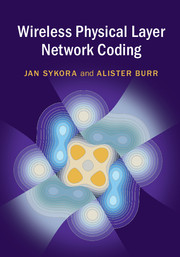Book contents
- Frontmatter
- Contents
- Preface
- Mathematical Symbols
- Abbreviations
- Part I Motivation and Gentle Introduction
- 1 Introduction
- 2 Wireless Physical Layer Network Coding: a Gentle Introduction
- Part II Fundamental Principles of WPNC
- Part III Design of Source, Relay, and Destination Strategies
- Appendix A Background Theory and Selected Fundamentals
- References
- Index
2 - Wireless Physical Layer Network Coding: a Gentle Introduction
from Part I - Motivation and Gentle Introduction
Published online by Cambridge University Press: 01 February 2018
- Frontmatter
- Contents
- Preface
- Mathematical Symbols
- Abbreviations
- Part I Motivation and Gentle Introduction
- 1 Introduction
- 2 Wireless Physical Layer Network Coding: a Gentle Introduction
- Part II Fundamental Principles of WPNC
- Part III Design of Source, Relay, and Destination Strategies
- Appendix A Background Theory and Selected Fundamentals
- References
- Index
Summary
The 2-Way Relay Channel
In this chapter we begin to describe the principles of WPNC, taking a more “gentle” approach than we do in the remainder of the book, minimizing the use of mathematics in favor of more descriptive and graphical approaches as a means to explain these principles. We will see that the simple example described in Section 1.4 already captures some of the important issues, but we will begin the process of generalizing it and setting it in the context of a complete network, albeit a very simple one.
Accordingly we focus on the 2-way relay channel (2WRC)1 as a very simple example of a complete network (in fact the simplest possible, as we will see in a moment) in which WPNC can be applied. The 2WRC is illustrated in Figure 2.1. The basic idea is that two terminals each have data to exchange with the other, but (perhaps because the distance between them is too great for a direct link) they wish to use an intermediate relay node for the purpose.
The reason for focussing on the 2WRC is that it provides a simple example of a multihop wireless network supporting multiple data flows, as well as being an example that demonstrates the benefits ofWPNC particularly clearly and one that is of some practical interest. In fact, as mentioned in Section 1.5, a large proportion of the work in the field in the past decade has exclusively addressed this network.
We emphasize here, following on from Section 1.2, that WPNC applies to wireless networks, not to individual point-to-point links – this is the essence of the “networkaware physical layer.” Such networks must necessarily involve more than one wireless “hop” between transmitter and receiver, and hence must include a relay node as well as source and destination terminal nodes. They must also necessarily involve more than one data source, leading to multiple data flows through the network that also interact at some point within it. On this basis the 2WRC, containing two terminal nodes and one relay and involving two flows each originating at one of the terminals, is in fact the simplest possible example.
- Type
- Chapter
- Information
- Wireless Physical Layer Network Coding , pp. 15 - 38Publisher: Cambridge University PressPrint publication year: 2018



